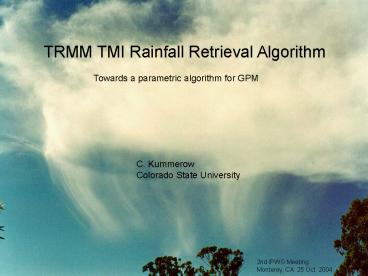TRMM TMI Rainfall Retrieval Algorithm PowerPoint PPT Presentation
1 / 17
Title: TRMM TMI Rainfall Retrieval Algorithm
1
TRMM TMI Rainfall Retrieval Algorithm
Towards a parametric algorithm for GPM
C. Kummerow Colorado State University
2nd IPWG Meeting Monterey, CA. 25 Oct. 2004
2
GPROF changes TMI-V5 V6 A net reduction of
approx. 5.
Databases - Created new databases with updated
model runs from (Taos group Greg Tripoli and
Grant Petty) - Changed all databases to ascii
for distribution - Added bright band calculations
to melting layers Background Tbs - Changed from
selecting the clearest Tb for the background Tb
to calculating the clear air Tb by removing
the wind speed and liquid water
components Freezing level - Interpolating
across adjacent pixels Convective Fraction -
Better account for the texture of the convection
3
August 2003
TMI (78.1 mm/month)
AMSR-E (75.2 mm/month)
4
Comparison with 16 month of GV data (PR and
Combined have changed since)
Courtesy of David Wolff
5
PR/TMI Global Bias Map
6
Rainfall Bias RemovalBased on Column Water Vapor
7
Need for Version 7
- Discrepancies (10-15) remain between PR and TMI
at spatial and temporal scales of interest to
climate. These need to be understood and
resolved. - Increasing number of microwave radiometers
require more parametric algorithms. We now
have - TMI
- AMSR-E (AMSR)
- SSM/I (SSMIS)
- WindSat
- Need to add more comprehensive error model.
Currently know random and sampling errors. Know
very little about systematic biases. - Cloud models used in the retrievals
- Regional/temporal changes in cloud properties
8
(No Transcript)
9
With initial assumptions
10
With updated assumptions
11
Validation of core satellite algorithm ?
Once radiances and rainfall can be matched, data
cube turns into ideal algorithm test and
verification site that is not limited by
infrequent over-passes of the core satellite.
Data Cube
12
Important aspects of Version 7
- V7 Database is essentially PR and is modified
only if emission signal of TMI indicates a change
is needed. - Database is more representative of observed
rainfall profiles but can only be constructed for
regimes (defined perhaps by SST or CWV) observed
by PR. Code for SSMI, AMSR will retain CRM for
colder surfaces until GPM is available. - A new validation paradigm will be needed for
these databases - V7 eliminates all screening routines (they tend
to be sensor dependent and make error modeling
impossible. Instead - Confidence that correct database is being used
- Probability of rain
- Mean conditional rainfall
- Uncertainty in rainfall (inversion uncertainty)
- Space/time error model
13
(No Transcript)
14
General issues with new algorithms
- A number of different algorithms exist for
constructing the a-priori databases for future
parametric algorithms. But - They currently exist only for tropical oceans.
- Have no way of judging if one method is better
than another - Some attention has been paid to land and
extratropics. But - Coordination is poor
- Methologies are different
- No work on how to transition from one method to
another - As the number of microwave sensors increases,
sampling becomes much better. But. - Standards dont exist (even simple things like
version numbers) - Quality assurance becomes more difficult
- Coordinated Version management is needed
15
Rainfall Detection Errors
16
Rainfall Detection Errors February 1, 2000
17
PR/TMI Bias vs. Column Water Vapor

